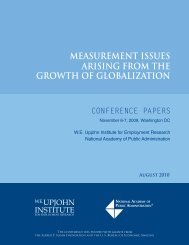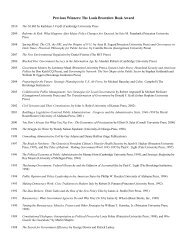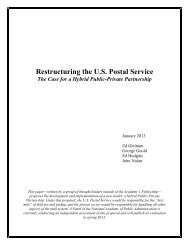High-Performance Partnerships - National Academy of Public ...
High-Performance Partnerships - National Academy of Public ...
High-Performance Partnerships - National Academy of Public ...
Create successful ePaper yourself
Turn your PDF publications into a flip-book with our unique Google optimized e-Paper software.
Coexistence:<br />
Cooperative:<br />
Contractual:<br />
If the city and the nonpr<strong>of</strong>it each rehabilitate five houses somewhere<br />
in the city.<br />
If the city and the nonpr<strong>of</strong>it each agree to rehabilitate five houses<br />
in specific neighborhoods and even coordinate their efforts to<br />
jointly purchase supplies.<br />
If the city develops a formal agreement with the nonpr<strong>of</strong>it to<br />
rehabilitate 10 houses for a specified cost.<br />
Collaborative: If the city and nonpr<strong>of</strong>it agree to work together to rehabilitate 10<br />
houses, and coordinate schedules and resources.<br />
Partnership:<br />
<strong>High</strong>-<strong>Performance</strong><br />
Partnership:<br />
If the city and the nonpr<strong>of</strong>it jointly decide which 10 houses to<br />
rehabilitate, jointly develop work plans, and share resources and<br />
accountability for accomplishing the work.<br />
The city/nonpr<strong>of</strong>it partnership rehabilitates 15 houses at the same<br />
total cost as the budget for 10 houses in a shorter period <strong>of</strong> time.<br />
DEFINING CHARACTERISTICS<br />
A high-performance partnership has two<br />
essential dimensions. First, it must have a<br />
structure for the individual organizations to<br />
share authority, resources, and accountability<br />
for achieving a mutually decided goal. Some<br />
reorganization, merger, or redefinition <strong>of</strong><br />
authority and responsibility takes place when<br />
the partnership is formed. Second, it must<br />
produce significant results. So, the second<br />
dimension takes the partnership to a higher<br />
level. A partnership is defined by its organizational<br />
structure and approach, while a high-<br />
Perhaps born from Hoosier pragmatism or a Midwestern<br />
culture that values community and church involvement,<br />
Indianapolis has a long, rich tradition <strong>of</strong> collaboration. A<br />
succession <strong>of</strong> mayors has embraced public-private partnerships<br />
for economic development and service delivery.<br />
Cross-sector human services planning began in 1978 and<br />
spawned several partnerships, including the Family<br />
Strengthening Coalition. The involvement <strong>of</strong> major funders—the<br />
United Way, Lilly Endowment, and Community<br />
Foundation—also spurred collaborative ventures. In short,<br />
Indianapolis has a culture <strong>of</strong> collaboration.<br />
Family Strengthening Coalition (Indianapolis)<br />
According to the 1990 Census, more than 120,000 people<br />
in the Milwaukee area were age 65 and older, with 14 percent<br />
older than 85. Mental health disorders and alcohol<br />
abuse are estimated to affect a significant portion <strong>of</strong> this<br />
population, perhaps as much as 35 percent. These elderly<br />
suffer serious health problems—including hypertension,<br />
arthritis, and coronary heart disease. They are potential<br />
candidates for nursing home care if they are unable to<br />
spend their years in an accommodating, service-oriented<br />
community. The urgent need to address these issues for<br />
low-income, fragile elders led to Milwaukee’s Lapham Park<br />
Venture, a partnership <strong>of</strong> local government, medical, and<br />
faith-based organizations.<br />
performance one is defined by what it produces.<br />
A high-performance partnership does<br />
not necessarily begin as a sophisticated operation.<br />
It can develop incrementally from less<br />
intensive forms <strong>of</strong> collaboration.<br />
External conditions must support a performance-based<br />
partnership and three environments—culture<br />
<strong>of</strong> collaboration, crisis, and<br />
funder-imposed—<strong>of</strong>ten provide the springboard<br />
for creating one. Collaboration is part<br />
<strong>of</strong> the social fabric in some communities that<br />
believe their long-term interests are best served<br />
by working together. With a history <strong>of</strong> cooper-<br />
15 Powering the Future: <strong>High</strong>-<strong>Performance</strong> <strong>Partnerships</strong>









